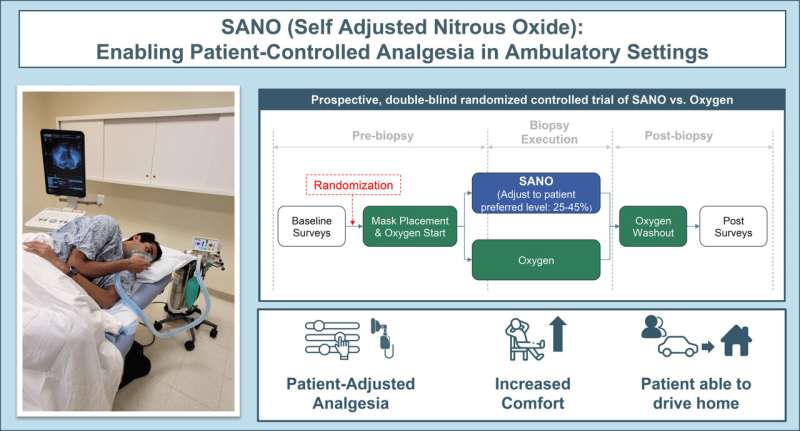This article has been reviewed according to Science X's editorial process and policies. Editors have highlighted the following attributes while ensuring the content's credibility:
fact-checked
trusted source
proofread
N₂O laughing matter: Self-adjusted nitrous oxide takes the pain out of prostate cancer screening procedure

Each year, more than a million transrectal biopsies are performed in the United States. The primary technique for diagnosing and monitoring prostate cancer, a transrectal biopsy, entails removing tissue from the prostate gland by inserting a thin needle through the rectal wall. Patients are awake for the procedure, and though typically given a nerve block to prevent pain during the procedure, many patients still experience physical and psychological discomfort.
In a recent study, investigators at Beth Israel Deaconess Medical Center (BIDMC) assessed whether self-adjusted low-dose nitrous oxide could improve patients' experience during transrectal prostate biopsy.
The team evaluated whether the gas, in addition to the nerve block, could decrease patient anxiety related to the needle biopsy, decrease perception of pain, and potentially impact urologists' perception of the procedure. Although there was not an observed difference in the primary endpoint of anxiety, self-adjusted nitrous oxide was associated with lower patient-reported pain scores.
The team's findings are published in the Journal of Urology.
"To our knowledge, this is the first prospective randomized controlled study assessing the effects of low dose nitrous oxide adjusted to patient preferred level on patient experience during transrectal prostate biopsy," said Heidi J. Rayala, MD, Ph.D., a urologic surgeon at BIDMC.
"The results of this study demonstrate that delivery of low-dose nitrous oxide titrated to a patient's desired effect during transrectal prostate biopsy is well tolerated and safe. With the reduction of patients' pain during prostate biopsy, our results suggest that the option of adjuvant nitrous oxide may improve patients' experience of care as they undergo diagnostic evaluation for prostate cancer."
Nitrous oxide, or laughing gas, is one of the oldest known inhaled anesthetics, with its analgesic properties for urologic procedures first reported in 1939. Minimally sedating, nitrous oxide carries several advantages over other anesthetics; when used at concentrations below 50 percent, it produces a state in which patients respond normally to verbal commands, maintain airway reflexes, and breathe normally on their own.
As such, they do not require the presence of anesthesia personnel. Nitrous oxide also takes effect within 3 minutes and wears off equally as quickly, meaning patients do not require post-procedure monitoring and are able to drive home independently.
To evaluate low-dose nitrous oxide's use in transrectal biopsies, Rayala and colleagues recruited males ages 21 to 85 scheduled for prostate needle biopsy at BIDMC between December 2021 and September 2022. All study participants received a nerve block, and half were randomized to receive nitrous oxide while the other half received oxygen.
In a double-blinded study, neither patients nor physicians knew whether the patient received nitrous oxide or oxygen during the procedure. All participants filled out questionnaires about pain and anxiety related to the biopsy before and after the procedure.
Post-biopsy pain scores were significantly lower in the self-administered nitrous oxide group. Urologist assessment of patient biopsy tolerance was better in the self-administered nitrous oxide group. Self-administered nitrous oxide did not demonstrate a significant outcome on anxiety scores; however, post-biopsy pain was significantly correlated with post-biopsy anxiety in both the nitrous oxide group and the control group.
"Notably, there was not an observed decrease in the study's primary endpoints related to patient anxiety," said Rayala, who is also an assistant professor of surgery at Harvard Medical School.
"However, there was an observed reduction in secondary endpoints of patient-perceived pain. Overall, self-administered nitrous oxide was well tolerated with no significant side effects. The self-administered nitrous oxide group's post-biopsy pain score was lower than that previously published in the literature and may suggest that the combination of self-administered nitrous oxide with nerve block is superior to either one alone."
"For transrectal biopsies, an inexpensive, titratable, rapid onset method for relieving patient anxiety and pain would be of great benefit to patients."
More information: Abigail J. Escobar et al, Practical Use of Self-Adjusted Nitrous Oxide During Transrectal Prostate Biopsy: A Double-Blind Randomized Controlled Trial, Journal of Urology (2023). DOI: 10.1097/JU.0000000000003789


















